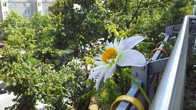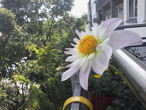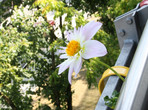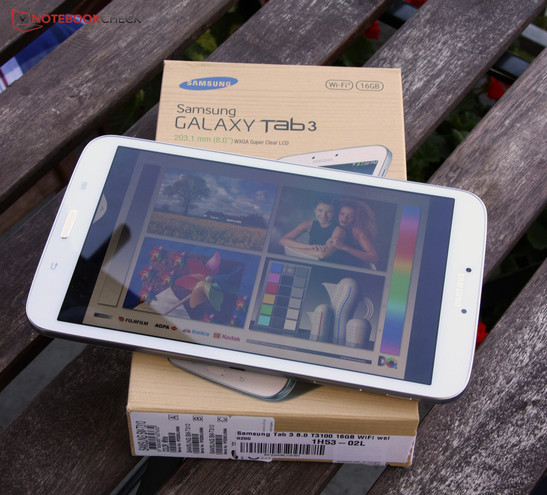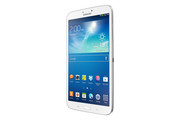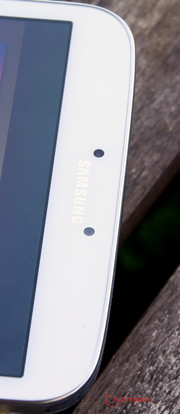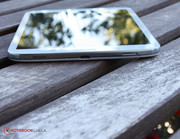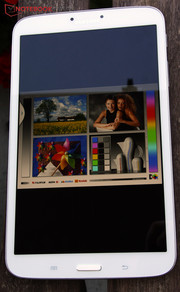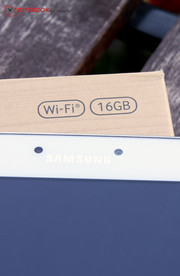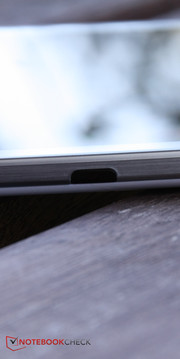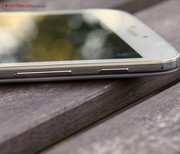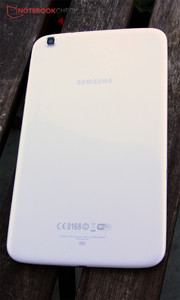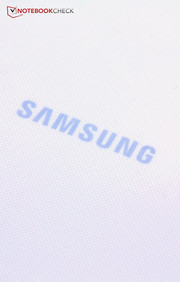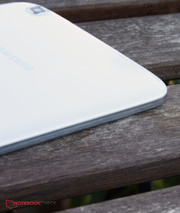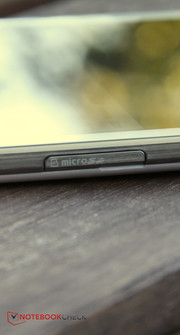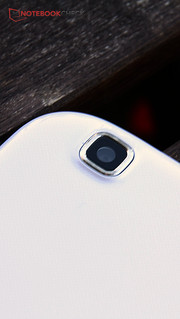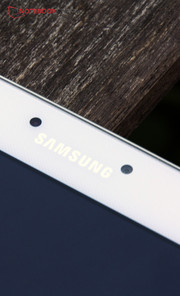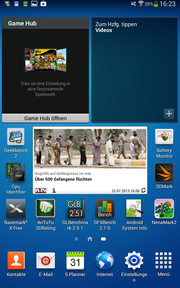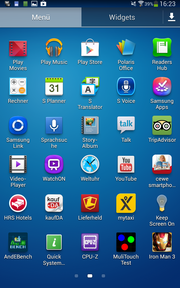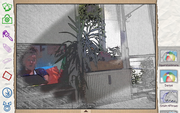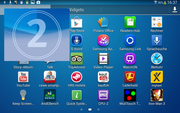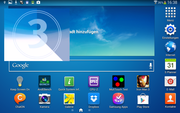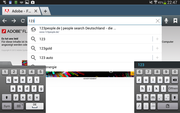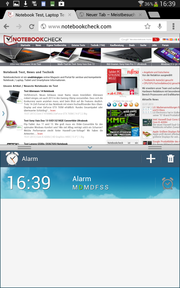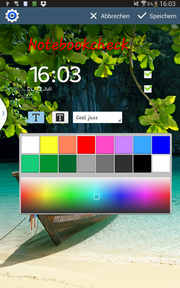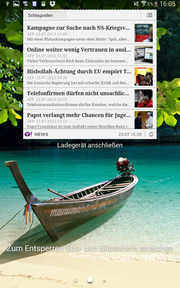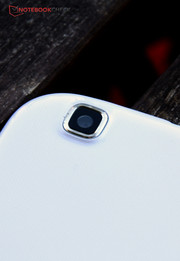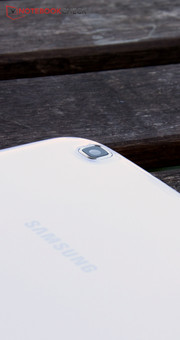Review Samsung Galaxy Tab 3 8.0 SM-T310 Tablet

For the original German review, see here.
The selection of Samsung tablets is not quite as large as that of its smartphones. Users can pick among an ATIV Tab with Windows 8, a Windows RT, or the Galaxy Note with Android, which is aimed more at business customers. And then we still have the Galaxy Tab series, which are the Android tablets for the private customers.
The latter has just entered its third generation - our test unit, the 8-inch version, is also part of it. Also available are the more common sizes of 7-inch and 10.1-inch. The entire model range comes in white finish; black versions are not available yet. The Galaxy Tab 3 8.0 has a relatively high price of 299 Euros (~$397) compared to other devices of the same size. Many manufacturers offer their 8-inch tablets for less than 200 Euros (~$266).
We therefore will compare the Galaxy Tab 3 8.0 to a couple of representatives of this class, in order to see if the extra cost is justified: Acer Iconia A1-810, Captiva Pad 8 Pro and EasyPix SmartPad EP800 Ultra for example, all have lower prices. The Lenovo IdeaTab A2109A is even larger at 9-inches and still cheaper. The "big" rivals from Google (Nexus 7) and Amazon (Kindle Fire HD 7) are smaller, but also significantly cheaper. Then we have the iPad Mini, which is available for 329 Euros (~$437). Finally, we take the Galaxy Note 8.0 in order to see how the tablets compete internally.
Case
"A suitable device for everyone? Then we'll make a standard design: it's cheaper and has a good brand recognition effect." This was more or less the thought process behind the Galaxy series of the Korean manufacturer. The Galaxy S4, the Galaxy Mega, the Galaxy Note and now the Galaxy Tab 3 are very similar in terms of design. The Note and the Tab 3 can actually be distinguished from the front only by the earpiece on the Note.
The Galaxy Tab 3 has, as the rest of the devices from the current Galaxy generation, a white back with subtle dot pattern. Workmanship and the surface feel very good, just as the Galaxy S4 and the Galaxy Mega. Of course, the only material used is plastic. The iPad Mini, which costs just 30 Euros (~$40) more, is far better with its aluminum unibody.
The tablet gives the impression of being very stable and compact. Pressing on the back barely leads to visible alterations on the display. You have to press both the sides and the screen at the same time in opposite directions in order to finally move the liquid crystals.
The dimensions are slightly more compact than the Galaxy Note 8.0: it is one millimeter shorter, one centimeter narrower, and about half a centimeter slimmer (~0.4 inches narrower and 0.2 inches slimmer). The iPad Mini is slightly thinner, but devices in the 8-inch class usually have bigger dimensions: the Captiva Pad 8 Pro is almost twice as thick as the Galaxy Tab 3 8.0.
Connectivity
The Galaxy Tab 3 does not feature pen input like in the Galaxy Note 8.0. Our test unit also came without mobile Internet capability, but it is available at a surcharge of about 100 Euros (~$133). The interfaces are also standard, only the infrared port stands out. Samsung has included it in order to make it possible to use the tablet as a remote control for other entertainment devices. Since you cannot remove the back cover of Galaxy Tab 3 8.0, unlike the smartphones, the card reader is also integrated on the side of the tablet.
Software
The Galaxy Tab 3 8.0 uses the latest version of Android 4.2.2. Samsung does not use a pure Google OS, but has also installed the TouchWiz: software that is based on the Android system, but in many areas it replaces and expands on it. Examples of this are the settings menu, the quick access toolbar, the voice control and the widgets on the home screen. You can read more about the individual customization in our review of the Samsung Galaxy S4.
It is annoying to see the extensive bloatware, such as advertising software, that greets the customer, especially after it was absent from the Galaxy Mega. Otherwise, the software package is quite good and features an Office Suite, a drawing application and a couple of other interesting apps. Still rather unnecessary is the need to create a Samsung account, in addition to the Google one for use of Android features, in order to be able to use a different application store with the "Samsung Apps".
Communication & GPS
The WLAN module does not support the newest standard 802.11 ac, but instead can use two bandwidths (2.4 and 5 GHz). It receives the signal from our router even at ten meters (~33 feet) distance and through three walls with 3/4 of the full power. The tablet does not feature NFC, but instead Samsung has implemented DLNA support and its own KIES technology, which aids in the connection to the PC.
The GPS chip also supports the Russian GLONASS network and offers, like the Galaxy S4, excellent reception. Out in the open we quickly managed to connect to a dozen satellites and even indoors, our position was still roughly determined.
Cameras & Multimedia
The performance of the 5 megapixel (2560×1920) camera is rather good in bright sunlight. In combination with the autofocus, the lens produces properly sharp images, without color bleeding even at the edges. However, the image quality noticeably drops in bright artificial or low light. We can clearly see image noise and slight blurring due to the long exposure. This is even worse when you take into account the lack of an LED flash.
HD videos were played without hiccups, both from the internal memory and streamed from other local devices over Wi-Fi. YouTube videos should be viewed with the dedicated app and not via the browser, because the quality of the videos is much better in the application. This is caused by the operating system, not the device itself.
Accessories
AC adapter, USB cable, quick start guide – Samsung has not equipped the Galaxy Tab 3 8.0 with a lot of stuff. However, the rest of the devices in this price range do not usually come with many more accessories. Samsung has traditionally created special accessories for its Galaxy Tabs, such as the "Diary Bag", which is available for the Galaxy Tab 2. There are still no such accessories for the latest generation on the manufacturer's website.
Warranty
Samsung offers its tablets with 24 months of warranty. This warranty can become valid in any country, where the Galaxy Tab 3 8.0 is sold, if you call the Samsung Hotline or an authorized service partner.
Input Devices & Controls
The capacitive touchscreen can recognize up to ten fingers at the same time. It is very sensitive and accurate even at the edges of the display. The multi-touch gestures are also reliably recognized.
Samsung has redesigned the standard Android keyboard: the buttons are slightly smaller, but the numbers are now directly accessible. With the press of a button, the virtual keyboard can be moved around the screen or split into two separate parts, on each of which can be typed with one hand. The fact that the keys are slightly smaller will not please people with larger fingers, but overall the keyboard proved to be quite good and reliable in our test.
Other input methods, such as handwriting recognition and dictating text, functioned well. The user can select which voice control to use, Samsung's or Google's one, in the settings menu. Both of these worked well in our test. For example, voice control can be used to take a picture so that the image is not blurred by the shake when you press the shutter button.
The Galaxy Tab 3.0 8 does not support a digitizer pen, unlike the Galaxy Note 8.0, but it offers almost all other input methods that TouchWiz supports - extended gesture control, face recognition that activates the screen, and comprehensive assistance for physically impaired people. You can read more about the control options of the TouchWiz in our review of the Galaxy S4.
Display
The heart of the Samsung Galaxy Tab 3.0 8 is a TFT display with a 16:9 aspect ratio. The resolution of 1280 x 800 pixels is higher than most cheaper competitors and even the iPad Mini.
Samsung has a reputation with displays and therefore does not skimp on the brightness - an average of 431 cd/m² is enough for the top position in any case. The illumination is very even at 92%, so there are hardly any visible differences in brightness over large areas.
| |||||||||||||||||||||||||
Brightness Distribution: 92 %
Center on Battery: 428 cd/m²
Contrast: 764:1 (Black: 0.56 cd/m²)
ΔE ColorChecker Calman: 4.2 | ∀{0.5-29.43 Ø4.79}
ΔE Greyscale Calman: 3.2 | ∀{0.09-98 Ø5}
Gamma: 2.46
CCT: 6621 K
Although Samsung has chosen a SAMOLED display this time, it is still quite a respectable panel: colors are crisp and the image is very good. The black level of 0.56 cd/m² is significantly higher than most other devices, and the contrast ratio of 764:1 is only average.
As with the Galaxy S4 and the Galaxy Mega, the Galaxy Tab 3 8.0 also has various screen modes, which are automatically selected or can be set by the user. Our subjective impression is that "Dynamic" has the strongest, but also slightly unnatural colors. "Video" has natural colors, but is a bit pale. "Standard" lies somewhere in between.
All three have a strong blue tint, as we measured with the CalMAN software and the colorimeter. Here it was confirmed that "Video" came closest to the sRGB and Adobe RGB color spaces. This applies to grayscale, as well as color accuracy and saturation.
"Dynamic" is the farthest from the ideal of all possible settings. In terms of color accuracy, its DeltaE values, meaning the deviation from the standard, are almost 50% higher than the ones of "Video" mode. What mode you like the best is ultimately a matter of taste. Overall, the display has quite accurate colors. The grayscale is sufficiently good even in comparison to Adobe RGB.
The very high brightness of the tablet makes it ideal for outdoor use, but the contrast and reflective surface work against it. Although it is possible to read the display in direct sunlight, after a short period it becomes tiring for the eyes. As long as there is bright ambient light, the user will be faced with annoying reflections from the screen. But, if you manage to find the right position or are in the shade, you can easily work well with the tablet outdoors.
Performance
While the Galaxy Note 8.0 featured a quad-core processor, Samsung has equipped the Galaxy Tab 3 8.0 with "just" a dual-core. The Exynos 4212 is manufactured by Samsung and works at 1.5 GHz. Our initial impression is that you cannot tell the difference between the equally clocked dual-core and quad-core processor in all application scenarios. However, the quad-core has a significant advantage in multi-tasking and when running properly programmed apps. We will check this with the help of synthetic benchmarks. The rest of the hardware equipment of the Galaxy Tab 3 8.0 is pretty neat: quad-core graphics chip, 1.5 GB of RAM and 16 GB flash storage.
We can briefly summarize the system and CPU performance of the Galaxy Tab 3 8.0 like this: faster than the Kindle Fire HD 7, significantly slower than the Google Nexus 7. The Galaxy Note 8.0 is also clearly ahead of our test device, thanks to its two additional cores. Overall, the Galaxy Tab 3 8.0 places in the middle and can even run several applications at the same time in everyday use. During video playback, navigation through the TouchWiz interface is also not a problem. Only in more demanding scenarios can one notice the performance difference to devices such as the Google Nexus 7.
| Linpack Android / IOS | |
| Single Thread (sort by value) | |
| Samsung Galaxy Tab 3 8.0 SM-T310 | |
| Samsung Galaxy Note 8.0 | |
| Captiva PAD 8 Pro | |
| Lenovo IdeaTab S2110A | |
| Acer Iconia A1-810 | |
| Easypix SmartPad EP800 Ultra | |
| Google Nexus 7 | |
| Amazon Kindle Fire HD 7 inch | |
| Apple iPad mini | |
| Multi Thread (sort by value) | |
| Samsung Galaxy Tab 3 8.0 SM-T310 | |
| Samsung Galaxy Note 8.0 | |
| Captiva PAD 8 Pro | |
| Lenovo IdeaTab S2110A | |
| Acer Iconia A1-810 | |
| Easypix SmartPad EP800 Ultra | |
| Google Nexus 7 | |
| Amazon Kindle Fire HD 7 inch | |
| Apple iPad mini | |
| AnTuTu v3 - Total Score (sort by value) | |
| Samsung Galaxy Tab 3 8.0 SM-T310 | |
| Samsung Galaxy Note 8.0 | |
| Captiva PAD 8 Pro | |
| Acer Iconia A1-810 | |
| Easypix SmartPad EP800 Ultra | |
| Google Nexus 7 | |
| Geekbench 2 - 32 Bit - Total Score (sort by value) | |
| Samsung Galaxy Tab 3 8.0 SM-T310 | |
| Samsung Galaxy Note 8.0 | |
| Captiva PAD 8 Pro | |
| Lenovo IdeaTab S2110A | |
| Acer Iconia A1-810 | |
| Easypix SmartPad EP800 Ultra | |
| Google Nexus 7 | |
| Amazon Kindle Fire HD 7 inch | |
| Apple iPad mini | |
| PassMark PerformanceTest Mobile V1 - System (sort by value) | |
| Samsung Galaxy Tab 3 8.0 SM-T310 | |
| Acer Iconia A1-810 | |
| Smartbench 2012 - Productivity Index (sort by value) | |
| Samsung Galaxy Tab 3 8.0 SM-T310 | |
| Samsung Galaxy Note 8.0 | |
| Lenovo IdeaTab S2110A | |
| Acer Iconia A1-810 | |
| Easypix SmartPad EP800 Ultra | |
| Easypix SmartPad EP800 Ultra | |
| Google Nexus 7 | |
| Amazon Kindle Fire HD 7 inch | |
In terms of 3D performance, none of the devices can really take a lead here; the results are quite close to each other. The ARM Mali 400-MP4 in our test device is enough even for very demanding 3D games for Android tablets. As you can see below, we have checked this in practice.
| GFXBench (DX / GLBenchmark) 2.7 | |
| T-Rex Onscreen (sort by value) | |
| Samsung Galaxy Tab 3 8.0 SM-T310 | |
| Samsung Galaxy Note 8.0 | |
| Acer Iconia A1-810 | |
| Google Nexus 7 | |
| 1920x1080 T-Rex Offscreen (sort by value) | |
| Samsung Galaxy Tab 3 8.0 SM-T310 | |
| Samsung Galaxy Note 8.0 | |
| Acer Iconia A1-810 | |
| Google Nexus 7 | |
| Epic Citadel | |
| High Quality (sort by value) | |
| Samsung Galaxy Tab 3 8.0 SM-T310 | |
| Samsung Galaxy Note 8.0 | |
| Acer Iconia A1-810 | |
| High Performance (sort by value) | |
| Samsung Galaxy Tab 3 8.0 SM-T310 | |
| Acer Iconia A1-810 | |
| Google Nexus 7 | |
| NenaMark2 - --- (sort by value) | |
| Samsung Galaxy Tab 3 8.0 SM-T310 | |
| Samsung Galaxy Note 8.0 | |
| Captiva PAD 8 Pro | |
| Lenovo IdeaTab S2110A | |
| Acer Iconia A1-810 | |
| Easypix SmartPad EP800 Ultra | |
| Google Nexus 7 | |
| Amazon Kindle Fire HD 7 inch | |
| 3DMark - 1280x720 Ice Storm Standard Score (sort by value) | |
| Samsung Galaxy Tab 3 8.0 SM-T310 | |
| Samsung Galaxy Note 8.0 | |
| Acer Iconia A1-810 | |
| Google Nexus 7 | |
As we already noted in our review of the Xtreamer JoyZ, Samsung's Exynos SoCs are really fast when it comes to Internet browsing, complex HMTL5 animations, or videos. The otherwise mediocre test device left behind all of its rivals in this test. The same is true for the Galaxy Tab 3 8.0 - none of the competitors can keep up. This is a strong argument for those who mostly use their tablet for surfing the Internet.
| Google V8 Ver. 7 - Google V8 Ver. 7 Score (sort by value) | |
| Samsung Galaxy Tab 3 8.0 SM-T310 | |
| Samsung Galaxy Note 8.0 | |
| Captiva PAD 8 Pro | |
| Lenovo IdeaTab S2110A | |
| Acer Iconia A1-810 | |
| Easypix SmartPad EP800 Ultra | |
| Google Nexus 7 | |
| Amazon Kindle Fire HD 7 inch | |
| Apple iPad mini | |
| Octane V1 - Total Score (sort by value) | |
| Samsung Galaxy Tab 3 8.0 SM-T310 | |
| Samsung Galaxy Note 8.0 | |
| Captiva PAD 8 Pro | |
| Acer Iconia A1-810 | |
| Google Nexus 7 | |
| Sunspider - 1.0 Total Score (sort by value) | |
| Samsung Galaxy Tab 3 8.0 SM-T310 | |
| Acer Iconia A1-810 | |
| Peacekeeper - --- (sort by value) | |
| Samsung Galaxy Tab 3 8.0 SM-T310 | |
| Samsung Galaxy Note 8.0 | |
| Captiva PAD 8 Pro | |
| Acer Iconia A1-810 | |
| Google Nexus 7 | |
| Mozilla Kraken 1.0 - Total (sort by value) | |
| Samsung Galaxy Tab 3 8.0 SM-T310 | |
| Samsung Galaxy Note 8.0 | |
| Captiva PAD 8 Pro | |
| Acer Iconia A1-810 | |
* ... smaller is better
Samsung has not saved on storage memory. The speed of the 16 GB flash memory is really impressive. This is confirmed by the comparison to the rest of the competition. In practice, we were equally impressed with the fast load times.
| AndroBench 3-5 | |
| Random Write 4KB (sort by value) | |
| Samsung Galaxy Tab 3 8.0 SM-T310 | |
| Samsung Galaxy Note 8.0 | |
| Captiva PAD 8 Pro | |
| Lenovo IdeaTab S2110A | |
| Acer Iconia A1-810 | |
| Easypix SmartPad EP800 Ultra | |
| Easypix SmartPad EP800 Ultra | |
| Google Nexus 7 | |
| Amazon Kindle Fire HD 7 inch | |
| Random Read 4KB (sort by value) | |
| Samsung Galaxy Tab 3 8.0 SM-T310 | |
| Samsung Galaxy Note 8.0 | |
| Captiva PAD 8 Pro | |
| Lenovo IdeaTab S2110A | |
| Acer Iconia A1-810 | |
| Easypix SmartPad EP800 Ultra | |
| Easypix SmartPad EP800 Ultra | |
| Google Nexus 7 | |
| Amazon Kindle Fire HD 7 inch | |
| Sequential Write 256KB (sort by value) | |
| Samsung Galaxy Tab 3 8.0 SM-T310 | |
| Samsung Galaxy Note 8.0 | |
| Captiva PAD 8 Pro | |
| Lenovo IdeaTab S2110A | |
| Acer Iconia A1-810 | |
| Easypix SmartPad EP800 Ultra | |
| Easypix SmartPad EP800 Ultra | |
| Google Nexus 7 | |
| Amazon Kindle Fire HD 7 inch | |
| Sequential Read 256KB (sort by value) | |
| Samsung Galaxy Tab 3 8.0 SM-T310 | |
| Samsung Galaxy Note 8.0 | |
| Captiva PAD 8 Pro | |
| Lenovo IdeaTab S2110A | |
| Acer Iconia A1-810 | |
| Easypix SmartPad EP800 Ultra | |
| Easypix SmartPad EP800 Ultra | |
| Google Nexus 7 | |
| Amazon Kindle Fire HD 7 inch | |
Games
As we already mentioned, the SoC is well suited to run the latest 3D games on the Android tablet. We tested the tablet with titles like "Real Racing 3" and "Iron Man 3". Both ran without problems – no stuttering, short loading times and smooth gaming experience. Clearly undemanding games like the "Angry Birds: Star Wars" were also not a challenge.
Overall the performance of the Galaxy Tab 3 8.0 is impressive: Despite its weaker processor compared to the Google Nexus 7 and the Galaxy Note 8.0, our tablet was usually ahead of the competition or at least on a similarly high level. In practice, the tablet worked quickly and without lags in any situation.
Emissions
Temperature
The performance edge is also reflected in the temperature under load: with a maximum temperature of 42.6 °C (108.68 °F), the tablet is by no means hot, but is still noticeably warm. The Amazon Kindle Fire HD 7 is slightly warmer, as well as the Galaxy Note 8.0. The rest of the competition has done a better job in terms of heat management and achieves lower average temperatures. In idle use, our test device keeps a cool head and reached a maximum of 34 °C (93.2 °F) in the area of the front camera.
(±) The maximum temperature on the upper side is 42.6 °C / 109 F, compared to the average of 33.7 °C / 93 F, ranging from 20.7 to 53.2 °C for the class Tablet.
(±) The bottom heats up to a maximum of 41.5 °C / 107 F, compared to the average of 33.2 °C / 92 F
(+) In idle usage, the average temperature for the upper side is 29.1 °C / 84 F, compared to the device average of 30 °C / 86 F.
Speakers
The speakers are located on the bottom side of the tablet. This means that if you hold the tablet in landscape mode, you can slightly cover the speakers with your hand and dampen the sound. When you hold it vertically, you will be able to fully enjoy the sound of the two speakers.
The sound is really good for a tablet - balanced, loud, but not too much. The highs and mids are well defined; the bass is of course barely there. Overall, the speakers leave a good impression, even if the stereo effect is not so prominent, due to the fact that the two speakers are too close to each other.
Energy Management
Power Consumption
Considering the more than decent performance that the tablet offers, its energy consumption is low. A maximum of 3 W in idle use is almost half of what the Acer Iconia A1-810 and Apple's iPad Mini are consuming. Even under load, our test unit draws very little power with a maximum value of 5.8 W. In combination with the 17.8 Wh battery, the tablet should have properly good runtimes, right?
| Off / Standby | |
| Idle | |
| Load |
|
Key:
min: | |
Battery Life
The answer is clearly "yes, but...". The lithium-ion battery provides the Galaxy Tab 3 8.0 with runtimes of more than 10 hours of very light use, 7:43 hours of surfing over WLAN and 3:36 hours of working under full load. These are quite ordinary times. The Google Nexus 7 can be clearly surpassed in the WLAN test. The iPad Mini and Kindle Fire HD 7 have significantly longer battery life, which places the Galaxy Tab 3 8.0 just in the upper middle of the list.
Verdict
Slightly more expensive than its competitors, but also slightly better. The Google Nexus 7 and the Amazon Kindle Fire HD 7, two considerably well-known competitors, cannot really challenge the Galaxy Tab 3 8.0. However, this may change soon, because the next generation of Google's price-performance hit is on its way.
But until then, Samsung has produced a tablet, which can be threatened only by the iPad Mini or the Galaxy Note 8.0. The Galaxy Tab 3 8.0 also suffers some criticism: the case is made of plastic, which may be pleasing to some and others would be indifferent. But then there will be some, who would say that a high-quality aluminum tablet is more appealing. Dear Samsung team, bloatware is also not good. And for those who look only at the pure performance, we should note that buyers will get a slightly less powerful processor.
The performance is top notch, be it browsing the web or playing games. The display is also impressive, only if it were not for the blue tint. The TouchWiz interface is very well thought out and expands the Android with numerous neat features; Samsung has even included many features to help out people with disabilities. Good battery life, dozens of input options, useful software additions and good speakers make for a well-rounded package, which justifies the small extra cost.










